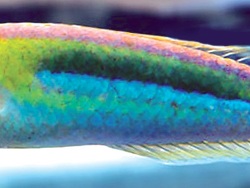Info
Pseudojuloides kaleidos Kuiter & Randall, 1995
Kaleidos wrasse
Pseudojuloides kaleidos, the Kaleidos wrasse or blue-nose wrasse. It lives on reef slopes and flats at depths of 20–35 m. The Kaleidos wrasse reaches 10 cm (3.9 in) in length. Both sexes begin a brownish pink color with a pale yellow tip on the snout, with males maturing to bright colors within about a week.
Jumping guard
A jumping guard prevents (nocturnal) fish from jumping out.
Wrasses, blennies, hawkfishs and gobies jump out of an unprotected tank in fright if their night rest is disturbed, unfortunately these jumpers are found dried up in the morning on carpets, glass edges or later behind the tank.
https://www.korallenriff.de/en/article/1925_5_Jump_Protection_Solutions_for_Fish_in_the_Aquarium__5_Net_Covers.html
A small night light also helps, as it provides the fish with a means of orientation in the dark!
Kaleidos wrasse
Pseudojuloides kaleidos, the Kaleidos wrasse or blue-nose wrasse. It lives on reef slopes and flats at depths of 20–35 m. The Kaleidos wrasse reaches 10 cm (3.9 in) in length. Both sexes begin a brownish pink color with a pale yellow tip on the snout, with males maturing to bright colors within about a week.
Jumping guard
A jumping guard prevents (nocturnal) fish from jumping out.
Wrasses, blennies, hawkfishs and gobies jump out of an unprotected tank in fright if their night rest is disturbed, unfortunately these jumpers are found dried up in the morning on carpets, glass edges or later behind the tank.
https://www.korallenriff.de/en/article/1925_5_Jump_Protection_Solutions_for_Fish_in_the_Aquarium__5_Net_Covers.html
A small night light also helps, as it provides the fish with a means of orientation in the dark!







 Dr. John Ernest (Jack) Randall (†), Hawaii
Dr. John Ernest (Jack) Randall (†), Hawaii
























